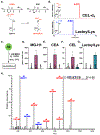Non-enzymatic Lysine Lactoylation of Glycolytic Enzymes
- PMID: 31767537
- PMCID: PMC7395678
- DOI: 10.1016/j.chembiol.2019.11.005
Non-enzymatic Lysine Lactoylation of Glycolytic Enzymes
Abstract
Post-translational modifications (PTMs) regulate enzyme structure and function to expand the functional proteome. Many of these PTMs are derived from cellular metabolites and serve as feedback and feedforward mechanisms of regulation. We have identified a PTM that is derived from the glycolytic by-product, methylglyoxal. This reactive metabolite is rapidly conjugated to glutathione via glyoxalase 1, generating lactoylglutathione (LGSH). LGSH is hydrolyzed by glyoxalase 2 (GLO2), cycling glutathione and generating D-lactate. We have identified the non-enzymatic acyl transfer of the lactate moiety from LGSH to protein Lys residues, generating a "LactoylLys" modification on proteins. GLO2 knockout cells have elevated LGSH and a consequent marked increase in LactoylLys. Using an alkyne-tagged methylglyoxal analog, we show that these modifications are enriched on glycolytic enzymes and regulate glycolysis. Collectively, these data suggest a previously unexplored feedback mechanism that may serve to regulate glycolytic flux under hyperglycemic or Warburg-like conditions.
Keywords: GLO2; HAGH; glyoxalase; hydroxyacylglutathione hydrolase; lactoyllysine; lactyllysine; methylglyoxal; post-translational modification.
Copyright © 2019 Elsevier Ltd. All rights reserved.
Conflict of interest statement
Declaration of Interests The authors declare no competing interests.
Figures




References
-
- Andon NL, Hollingworth S, Koller A, Greenland AJ, Yates JR 3rd, and Haynes PA (2002). Proteomic characterization of wheat amyloplasts using identification of proteins by tandem mass spectrometry. Proteomics 2, 1156–1168. - PubMed
-
- Antognelli C, Ferri I, Bellezza G, Siccu P, Love HD, Talesa VN, and Sidoni A (2017). Glyoxalase 2 drives tumorigenesis in human prostate cells in a mechanism involving androgen receptor and p53-p21 axis. Mol Carcinog 56, 2112–2126. - PubMed
-
- Cong L, and Zhang F (2015). Genome engineering using CRISPR-Cas9 system. Methods in molecular biology 1239, 197–217. - PubMed
Publication types
MeSH terms
Substances
Grants and funding
LinkOut - more resources
Full Text Sources
Research Materials
Miscellaneous

